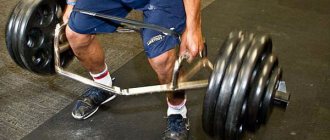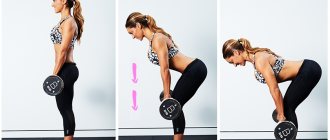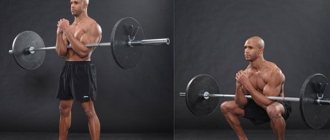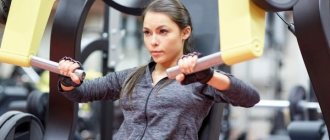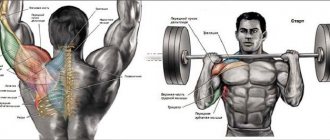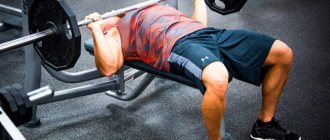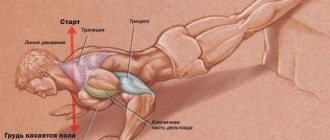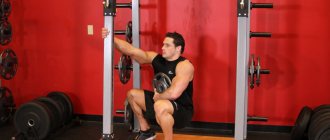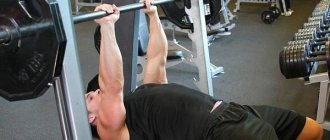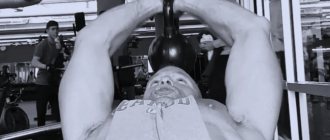The best exercises on block machines
Performing exercises on a block machine allows you to diversify your training program and improve progress in building muscle volume. The peculiarity of such classes is that they are radically different from training with free weights.
The blocks in the simulator can be pulled back and forth, to the sides, down and up. Free weights do not provide such flexibility, and muscles do not receive such comprehensive development. The muscles are worked out completely differently when the athlete trains on a block machine.
Lifting the barbell for biceps and performing crossover curls while standing have some differences in the technique of movement, and, consequently, in the impact on the muscles. This also applies to bent over arms, which are done in the simulator, which differs from the usual exercise with dumbbells, since the upper pectoral muscles work somewhat differently.
The variability of positions that block exercise machines provide is the main and main advantage of this sports equipment. Block exercises allow you to stimulate muscle growth. Athletes who previously worked only with free weights achieve especially high results.
Training the bottom
To pump up your buttocks efficiently, you can use a crossover. Here you can do the following:
- Deadlift
from the lower block. A good alternative to dumbbells for strengthening your hamstrings. - Squats
from the lower block. This version of the squat is good because the entire load goes to the back of the thigh and buttocks. At the same time, the abs and back work well, but the knees are practically “off”. - Taking your legs back and to the side.
This version of the swing will allow you to pump up the gluteus medius and minimus. Special cuffs are put on the legs, which are attached to the exercise machine. And each leg is worked out in turn: we move it back or to the side until the gluteal contraction and return to the starting position.
Ten best exercises on blocks
They represent a selection of the most effective exercises, which, for one reason or another, disclosed in the presented description of each, should be included in the main training program for increasing muscle mass.
No. 1 Pulley block to the belt from a sitting position
It is a multi-joint exercise that is aimed at training the back using several muscle groups, allowing you to use fairly heavy weights. It, unlike a single-joint one, stimulates the production of much more testosterone and growth hormone in the body of athletes. This has a positive effect on muscle growth. You can work with both the lower and upper grip, as well as with a narrow and wide grip.
It is best to perform this exercise at the end of a workout to develop your back muscles. First you need to work with heavy weights, performing deadlifts, bent-over rows with a barbell, supplementing, if possible, with T-bar rows. Expanding the range of motion is achieved by performing the exercise with one hand.
No. 2 Pulldown of the lower block to the chin
Aimed at working out the shoulder girdle. It is one of the best ways to engage and train the middle fascicle of the deltoid muscle group. Gives the greatest effect with a wide grip. Maximum isolation is achieved by occupying one of three positions - standing with cables (two), on the floor, sitting. Performing with a bar that has rotating handles allows you to relieve the stress on your wrists.
This exercise is best done before single-joint deltoids and after heavy overhead presses. It is often used as a closing dropset when people want to work out the middle fascicles of the deltoid muscles to the maximum.
No. 3 Thrust of the upper block to the chest
Working with free weights involves moving your arms perpendicular to your body. In this back exercise with a block machine, the amplitude is much greater. In addition, the athlete has the opportunity to experiment with different grips and types of bar, which is also an undeniable advantage.
Many athletes perform this exercise as a warm-up for the shoulder girdle, since it has a high range of motion. And if regular pull-ups make it difficult to increase the load, then doing heavy approaches on blocks is much easier. Pulling blocks to the chest can also be done after free weight exercises that follow the warm-up.
No. 4 Bending arms in a crossover from a standing position
This is perhaps one of the best variations of biceps development in such a simulator as a crossover. Its high efficiency is due to the ability to change the height of both the block itself and the position of your own body. This exercise is an excellent choice for those athletes who have a shoulder injury, as it provides the joint with almost complete freedom of movement.
The exercise is not characterized by a high load; it is great for performing in those moments when there is a need to reduce the intensity. It can also be done using fairly heavy weights. The main thing, when reaching muscle failure, is to be sure that the inertia of movement is not involved.
The latter is due to the fact that due to cheating the execution technique is disrupted. This results in an increased risk of injury. Workouts with sets of six or eight repetitions are recommended to be performed with both arms, either a barbell or an EZ bar.
No. 5 Bringing hands together in crossover
Unlike many other chest exercises, it allows you to easily change the angle of resistance. If it is necessary to work the lower part of the pectoral muscles, the blocks are placed at the top, and if the emphasis is on the upper part, then, on the contrary, the blocks are placed at the bottom. Similarly, a change in the point of bringing the hands together is required.
It is made the penultimate or final one in training. When two isolation chest exercises are performed at once during a class, the muscles should be worked from different angles. Otherwise, the loads will be unidirectional, which is not effective.
It is a work on the deltas, which involves swinging to the sides and raising the arms in an inclined position. Recommended for inclusion in training, since block exercise machines were designed specifically for single-joint exercises.
The triset allows you to develop literally every fascicle of the delta, holding the handle and not releasing it. You can spread your arms while standing or bending over, raise them in front of you or swing them to the sides.
This triset usually completes the workout. In what part of the lesson to do this exercise is not of paramount importance. The main thing is to make sure that the work on each beam is the same and not different.
No. 7 Crossover crunches
It differs from similar exercises performed with your own weight in the ability to conduct training with an unlimited number of repetitions, the number of which depends on the goal set for the athlete, as well as the adjustment of maximum loads. Crunches can be performed either on the knees, when the emphasis is on the upper abdominals, or while standing, if it is necessary to work the oblique muscles.
The crossover exercise is done either first or second in training to work the abdominal muscles. Taking a light weight and thereby increasing the number of repetitions, you can do crunches closer to the end of the session.
No. 8 Arm extensions with a rope in a crossover
The reason this exercise is included in the list of the best is that it allows you to get the most out of the long head of the triceps. This is due to the fact that it is much easier to return to the original position in a crossover than when using an EZ bar or dumbbells. This extension can be diversified in several ways, if you stand on your knees or perform it using one hand.
Athletes who work their triceps through multi-joint exercises can do this exercise absolutely at any time during training, after the previous ones have been completed.
No. 9 Abduction and adduction of the arm in crossover
Some athletes believe that performing rotator cuff exercises is purely a waste of time. This is a misconception. This group of muscles and tendons, which together with the deltoid muscles, provides maximum stability to the shoulder joints and also reduces the risk of injury.
It is the lack of exercises that allow you to work the rotator cuff, when the rest of the deltoids are given increased attention, and becomes the main cause of problems. This creates an imbalance in muscle development, which leads to negative consequences and negatively affects the health of the shoulder girdle. To perform abduction and adduction not in a crossover, but with a dumbbell, this must be done either standing or lying down.
You should do five repetitions in each approach as a warm-up to do arm adduction and abduction with light weights.
Fitness exercise crossover
The crossover exercise has recently become popular in gyms, because lack of funds is the main problem that owners of such complexes have to face.
The only way out of this situation is to use various alternative exercises that will help to better develop the deltoid muscles, define them and make them more dry.
But no matter how hard we try, the crossover is the only exercise machine that allows you to enlarge the upper biceps and also define the deltoid muscles.
Deltoid muscles.
The technique for performing the crossover exercise is quite simple. But we need to know what exactly we want from the exercise. If we need to pump up the deltoid muscles, then the exercise should be performed in the following style:
Important!
Moreover, it is important to understand that when you perform a crossover exercise, heavy weights are very, very unhelpful. Using small weights, proper exercise technique and the correct range of motion will allow beginning athletes to avoid injury.
And an injury at the initial stage of your career can even affect you in sports for the rest of your life. By the way, an excellent option for pumping up the deltoid muscles will allow you to implement a body solid crossover.
Its price is not that high, and the quality is one of the best in Europe.
The next stage is pumping the pectoral muscles on a crossover.
Here things are a little different. The fact is that the pectoral muscles develop exclusively from the bench press of the barbell, as well as from push-ups on the uneven bars. Of course, this also includes the option of push-ups.
But we will do purely exercises in the gym. Who goes to the gym to do push-ups? Therefore, carefully watch the video and remember the technique of performing the exercise.
There are a lot of variations in execution on a crossover, but it’s not a fact that the technique is correct everywhere:
It is also still possible to perform biceps exercises using a crossover, but this is more related to drying out the muscles, as well as isolating individual bundles of fibers on the body. For a beginner athlete, such exercises are a complete waste of time + also a lot of fatigue after training. Don't do nonsense and don't waste your energy!
Crossover shoulder exercises
The crossover is a block exercise machine, the design of which allows you to perform a wide variety of exercises for all muscle groups. Thanks to its multifunctionality, the crossover has become widespread and can be found in almost any gym. This popularity, multifunctionality and ability to level out some of the technical flaws that beginners make when performing exercises with free weights forces us to touch in more detail on the topic of integrating this simulator into the training process. In this article we will talk about crossover exercises for the muscles of the shoulder girdle. Why shoulder exercises?
The importance of the shoulder girdle is difficult to overestimate! For men, the shoulders complete the silhouette of the upper body; for girls, the shoulders emphasize the fragility and femininity of the figure, while simultaneously helping to create the illusion of a “wasp waist.” For men, of course, the basis of the entire training process is high-intensity cycles, during which heavy basic exercises, “ failures ” and so on are used, but, firstly, beginners must “pump up” for some time, and, secondly, after In addition to intensive cycles, there is also always a high-volume cycle, during which the athlete is also “ pumped up ” . Can this be done with free weights? Yes, it is possible, but beginners do not have sufficiently developed technical skill for this, and more experienced athletes often experience injuries that force them to resort to tricks. But even if there are no obvious reasons, then for the sake of variety or for personal reasons you can integrate crossover shoulder exercises into your training without fear of losing its effectiveness.
What muscles work when bringing your arms together in a block?
The main muscles involved in the work are the pectoralis major muscles. The load also goes to the abdominal muscles and latissimus dorsi muscles. The biceps and anterior deltoids receive a small share of the load.
Briefly about the anatomy of the shoulder girdle
As you may have noticed, the shoulder girdle is formed not only by the deltoid muscles; there are also a lot of other superficial, postural, large and small muscles attached to the humerus. In this regard, the athlete should think not only about how to load the target deltoids, but also about how to exclude more massive muscle groups from work. Why? Because the body always follows the path of least resistance! If stronger muscles can work instead of the shoulders, then the body will innervate them. This is simply the law of conservation of energy. This means you understand that you are training for a specific purpose, and the body is performing a physical task, trying to minimize energy costs. This must be understood and remembered!
The topic of the anatomy of the shoulder girdle is, in general, very interesting, but we touch on it in this article only to the extent necessary to form a correct idea about shoulder training for an inexperienced reader. Therefore, before “throwing slippers,” accept the fact that not everyone is as erudite as you are and may not know some banal things, however, their area of knowledge may be wider in some other area. So what's important? The important thing is that the shoulder joint is located in the spine of the scapula and is limited above by the acromion. This means that the deltoid muscles perform adjacent functions to the muscles that move the scapula, and these are, first of all, the latissimus dorsi muscles, and that the shoulder joint is very mobile.
You see that the shoulder can be moved literally in any direction, and the radius of its movement is limited only at the top by the acromion. Which deltoid you use to lift the humerus up depends on which deltoid is located above the axis of the shoulder joint. You can verify this yourself by raising your hand forward, to the side, or pulling it back. The most obvious way to see this is by raising your arm forward. If you raise your arm forward with your elbow facing the floor, you will feel the innervation in the anterior deltoid bundle, and if your elbow looks to the side, you will feel the innervation of the middle deltoid bundle.
You can raise your arm up both by bringing the scapula up and by rotating the humerus. This movement can be easily caught by fixating on it, if at this time there is no additional weight in your hands. So, if you perform any exercise on the shoulders, it doesn’t matter, in a crossover, with dumbbells, a barbell or a kettlebell, displacing the shoulder blade, then the load will go to the latissimus dorsi muscles, and the exercise will lose all meaning. It is necessary to perform exercises on the shoulders with a fixed shoulder blade, in such an amplitude that the movement, for the most part, can be performed due to the movement of the humerus.
Raising the arms at the upper crossover blocks to train the posterior deltoid muscle
This is the third exercise for working the posterior deltoid muscles in our selection for pumping up the shoulders; we pay special attention to them, since they are difficult to work out. The peculiarity of training the rear deltoid is that it is difficult to isolate it from other muscles
The work may involve the latissimus dorsi and triceps muscles; therefore, to achieve point loading, we use various exercise machines. We performed the first two exercises in a Smith machine, the third we will perform at the top block of the crossover (cable trainer).
The exercise is called arm raises at the upper crossover blocks to train the posterior deltoid muscle.
- Set the required weight in blocks, start with the minimum - warm-up, in order to avoid the risk of injury.
- Go to the top block of the crossover and stand in the center. Grasp the handles of the cables with an overhand grip, so that the left handle is in your right hand and the right handle in your left. Bring one leg forward and bend the other slightly for added stability.
- Bring your hands together in front of you, they should be at eye level.
- Move your arms back, and all movement should occur in one line at eye level.
- After completing the exercise, spread your arms and alternately place the blocks in their starting positions.
People often make mistakes when training their rear delts. For example, in this exercise, the standard mistake is to pull the head back, squeeze the shoulder blades together and engage the triceps.
When we move our heads back, we bend more, which increases muscle tension between the shoulder blades. Therefore, keep your head straight and do not lean back. It is also undesirable to pull your arms back too much and place stress on the middle of your back. Do a partial amplitude and do not move your arms back, then you will effectively pump up the rear deltoid muscles.
The last mistake is including the triceps in the exercise, or rather finishing with it. Try to fix your hands at the elbow joints.
Basic crossover shoulder exercises
Sources:
Adolfo Cassan "Illustrated Atlas of Human Anatomy"
Frederic Delavier "Anatomy of strength exercises"
Crossover trainer: design and training features
Almost every gym has a universal block-type device called a crossover. Its classic design consists of two power blocks connected by a frame. There are other modifications of the simulator:
- single-sided block rack;
- corner crossover;
- triple design;
- double block or block frame.
All crossovers are equipped with upper and lower traction blocks, the height of which is adjustable depending on the height of the athlete and the goals of the activity.
Advantages of working in a block simulator
Crossover training is characterized by great variability: here you can influence the target muscles in a variety of ways from different angles.
Working with free weights has many benefits, but it tends to lose some of the load as you return the weight to the starting position with each repetition. This does not happen in a crossover: due to the specifics of the cable-pulley system, muscle fibers actively work regardless of the phase of the exercise.
Any movement in this simulator, due to the cable mechanism, occurs in accordance with a given vector. This minimizes the work of stabilizer muscles and makes it possible to feel the contraction of the target muscles, which is important for beginners. However, if a beginner athlete is interested in gaining muscle mass, he should not avoid basic exercises with free weights.
Working out the shoulder muscles in a crossover
The muscles covering the humerus are the object of intense training for gym goers. The biceps (biceps muscle located on the inside of the shoulder) and triceps (three muscle bundles on the back of the humerus) form an attractive shape of the arms and are an indicator of decent physical shape. To give greater clarity to this area, a crossover is used.
Exercise crossovers
Good day to all. Today we’ll look at an interesting exercise called crossovers.
The crossover exercise targets the lower and inner parts of the pectoral muscles.
The exercise is isolating and targets the chest muscles.
Unlike other exercises for developing chest muscles, such as the bench press, the triceps and deltoids are practically not involved in the movement.
This allows targeted and isolated action on the pectoral muscles. It will not be possible to build up a huge mass of pectoral muscles by performing crossovers, but it is quite possible to give shape and relief.
To perform crossovers, we need a block simulator. Most gyms have it. Of course, you won’t be able to train at home. Look at the photo to see what the simulator looks like.
How to do crossovers exercise
So, we get into the simulator between the blocks. To provide greater stability, you can place one leg slightly forward. We grasp the handles of the simulator with our hands. We bend the torso slightly forward. We bend our arms slightly at the elbow joints, palms facing each other. Hands are spread to the sides. This is our starting position.
We take a deep breath and, tensing the chest muscles, bring our arms in front of us and slightly down, approximately at the level of the lower part of the pectoral muscles. After touching your hands, strain your chest muscles as much as possible, exhale, then slowly return your hands to their original position. In the starting position, the pectoral muscles are stretched to their maximum. We do the planned number of repetitions.
You can see the correct exercise technique here.
Throughout the movement you should feel the pectoral muscles working. In principle, in terms of execution technique and effect, this movement is similar to lying dumbbell flyes.
Attention!
So you can use it at home. However, in terms of the degree of impact on the muscles, it is significantly superior to dumbbell flyes, i.e.
at the moment of contact of the hands, maximum tension is maintained in the chest muscles, in contrast to lying flyes.
There are various options for crossovers: standing, sitting, reclining, kneeling. This allows you to work the chest muscles from different angles and intensify your approaches. In addition, some craftsmen manage to work on each hand separately. In my opinion, this is a perversion. I do it classically - standing.
Keep your body still throughout the entire approach. If you have to help yourself by moving your torso (cheating), you should reduce the working weight. Also, do not bend your arms at the elbow joints, as the movement turns into something like a press and some of the load is removed from the pectoral muscles.
At the same time, do not put them off until the very end of the workout, when you no longer have the strength to intensively work on the pectoral muscles. The ideal option is somewhere in the middle of the workout.
3-4 sets of 8-12 repetitions each are enough.
Include crossover exercises in your training program and you will build the chest of your dreams!
In the near future, I plan to write an excellent drying technique, thanks to which you will get rid of excess fat and not lose muscle tissue. So don't forget to subscribe to blog updates and receive the latest articles in your email.
PS. By the way, I advise you to familiarize yourself with the nuances of the technique of basic exercises in video format.
Crossover shoulder training. Pump up your deltoids wisely
A beautiful, rounded shoulder shape is a desired goal for many athletes who train, but how to achieve it if time passes and the shoulders are far from ideal. Variety in training plays a big role in the formation of muscle mass, because our muscles somehow get used to the monotonous nature of the load and adapt to it, which eliminates training stress and how it eliminates the growth factor.
You can return your muscles to tone and continue to progress by increasing the working weight, changing the time under load and training volume, or changing the exercises.
The alternation of various exercises has a positive effect from both a psychological and physiological point of view, as the emphasis of the load shifts.
In this article we will present exercises that can be performed in a crossover simulator and which will help you diversify your workouts.
1.
Pulling with a wide/narrow grip through the lower block
Pulling is an effective exercise for working the deltoid muscles, and the advantage of working in a crossover is that we do not use the stabilizer muscles to hold the weight in a level position, but work directly with the working muscle group, namely the deltoid muscles .
The width of the grip determines which part of the deltoid muscles will be used to a greater extent, the middle or the front.
Attach the straight handle through the lower block of the crossover, grab it with your hands, move a short distance from the pulley system and slightly tilt your body forward. Perform the stretch by raising your elbows as much as possible without twisting your wrists.
2.
Swing your arm across the side in front of you/behind
Secure the handle through the lower block, standing sideways to the pulley system, hold the handle with the opposite hand, lift your arm across the side, with your elbow just above your wrist or at the same level as it. We lift until the shoulder is parallel to the floor, after which we smoothly return the arm to its original position. With this variation of the exercise, the main load goes to the middle and anterior deltoid muscles.
It is also possible to perform swings when the cable of the simulator is behind your back, and in this option we first of all perform lifting of the elbow through the side. In this variation, the target muscles are the posterior and middle deltoids.
3.
Bent-over side swing
This exercise can be performed with both hands simultaneously or alternately.
Grasp the handles attached to the lower block, bend your knees slightly and take a tilted position so that your body is parallel to the floor. The arms are crossed and the elbows are slightly bent. Extend your arms out to the sides so that your elbow moves straight up and your arms are perpendicular to the floor. Perform a second delay at the top point to squeeze the muscles and smoothly return your arms to the starting position.
The advantage of working the deltoid muscles in a crossover compared to dumbbells is that the stabilizer muscles are less involved in the work and there is less risk of injury, and the trajectory of movement is more accurate. Also, thanks to the block system, our muscles are under tension from the very beginning of the movement trajectory to the top point.
We hope you found our article useful, subscribe to smart fitness
, and our VKontakte group “smart fitness”.
Varieties of exercise
The classic vertical method of execution is not the only one; there are others: inclined, from lower blocks, from a lying position. All of them allow you to diversify the load and involve other muscles in the work, except the pectoral one, if there is a need for this. The general safety rules are the same: stable support, springy arms, smooth movements and optimal weight selection. Technique for performing the listed exercises:
- Oblique execution. It differs from the usual one in that it is done at an angle (but not more than 45 degrees). The body is strictly motionless, the legs are parallel to each other and shoulder-width apart. The pectoral muscles work, but there is more stress on the back. Useful for strengthening the muscle corset. A common mistake when performing back crossover exercises is straightening up after each repetition. This may cause injury.
- Work from the lower block. In the starting position, the arms are lowered down. Information in the crossover through the lower blocks is designed to work the pectoral and deltoid muscles. You need to take a small step forward to increase the tension. Then smoothly bring your hands to chest level and lower them back to the starting position. A common mistake is to do the same movement by contracting the forearm muscles.
- Horizontal information. The lower block is also used for execution. A bench is placed in the center of the machine. Its position is chosen in such a way that the athlete does not twist his arms in the starting position. You need to sit on a horizontal bench, your feet should be firmly touching the floor. An assistant hands the handles. He also ensures that the bench is positioned correctly. Starting position - arms raised to chest level, spread to the sides, almost straightened (elbows slightly bent to avoid injury). Then a movement is made up and to the center, the arms converge above the chest. A common mistake is to “drop” your arms under the influence of traction when returning to the starting position. This is dangerous for back or shoulder injury.
Incorrectly placed weight on the blocks can lead to injury; it is especially noticeable during horizontal movements.
With an inclination
From the bottom block
Lying down
Basic shoulder exercises
Beautiful and voluminous shoulders are an attractive appearance for both an athlete and an ordinary person. Developed shoulders bring the body shape closer to a V-shape, making the figure more athletic.
Let's look at some basic shoulder exercises that will help you achieve a powerful upper body and will be an excellent incentive for further muscle gain.
How to organize training correctly?
The decision to pump up your shoulders does not arise out of nowhere. Either someone persistently recommended this to you, or in the process of working on yourself you felt that not everything was okay with this zone. In the first case, the most logical option is to start going to the gym. And you will definitely need a trainer who will assess your initial condition, set priorities and recommend a course of effective shoulder exercises.
If you are not new to sports, an instructor is not necessary: you will be able to develop a training plan yourself. It doesn’t matter where you train – in the gym or at home. The main thing is to have access to the necessary athletic equipment.
And don't forget the three principles of effective training:
- regularity;
- continuity;
- progressiveness.
In other words, classes need structure. Let the interval between training days be long but stable. The training process itself must be continuous. If you have allocated 1 hour for yourself, then you cannot take unplanned breaks during it. It is important to gradually increase the load, but at the same time maintain proper technique.
Shoulder anatomy
The shoulder muscle is otherwise called the “delta” for its similarity to the triangular shape of the Latin letter of the same name. The biceps and triceps are located lower and do not belong to the deltoid muscle. Therefore, an athlete doing shoulder exercises must understand that as a result, only his upper arms will be pumped up, but not his arms themselves. It is for this reason that delt exercises are suitable for girls who want to have relatively broad shoulders, but do not want to be too muscular.
The deltoid muscle is attached to three bones: the humerus, scapula and clavicle. When performing exercises, take into account the individual characteristics of the body. If you have had fractures or dislocations of the listed bones, it is recommended to exercise only with a trainer, and loads should be limited. A similar requirement applies to injuries of the shoulder joints or their ligaments.
The delta consists of three bundles: anterior, middle (lateral) and posterior. Let's look at their location and participation in training in more detail in the table.
Crossovers on the upper blocks
22 October 2020 Admin page » Breast
The technique for correctly performing crossovers on the upper blocks, the muscles being trained, the starting position, important tips + video are described.
Crossover exercises
An excellent isolated exercise that, along with a pullover, allows you to stretch the pectoral muscles well, draw and give them relief, without overloading the elbow joints, thanks to the handle and the cable attached to it.
You are unlikely to gain mass on them, so to gain mass, all you have to do is bench press, and for those who want to make their chest more defined by highlighting all the muscles, welcome and let’s go.
Crossovers can be performed using both upper and lower blocks, therefore, different groups of chest muscle fibers are involved in the work. It is advisable to perform this exercise at the beginning of training the pectoral muscles, to pre-fatigue them, while the triceps remain fresh for performing the bench press.
Muscles trained
When bringing the upper blocks to the bottom, the main load falls on the inner and upper part of the pectoralis major muscle, the middle bundle of deltas, serratus anterior, trapezius, biceps and upper abs are additionally loaded,
INITIAL POSITION
Stand between two racks of the exercise machine, take the handle of the exercise machine to which the cable is attached in your hands with a closed grip on the left and right sides, with your palms facing down.
Feet shoulder-width apart, bend your torso forward, forming approximately an angle of 60-70o, do not slouch your back straight, buttocks are slightly pulled back, elbows rotate and look up, abdominal muscles are tense, head looks forward.
TECHNIQUE
Having taken the correct position, bend your elbows slightly, take a deep breath and, using the strength of your arm muscles, move the upper blocks down at waist level (the movement should resemble as if you were pulling your arms down to hug the girl’s hips).
At the lowest point, additionally tighten your chest muscles and hold in this position for 2 seconds, then relax your arms and return the handle of the exercise machine to the upper position. Do not forget to breathe during the entire movement, lowering the handle down - exhale, moving them up - inhale.
1) The lower you move your arms on crossovers, the greater the load on the lower chest; the higher you move, the greater the load on the upper chest;
Important!
2) When you bring your arms forward, move in a crescent (semi-circle), do not squeeze the weight with the force of the triceps, if this works and you can’t do it any other way, then reduce the working weight;
3) Crossovers on the upper blocks are not a basic exercise for gaining mass, it helps to sharpen the pectoral muscles, make them more attractive, correct them, so do them at the end of the pectoral workout;
4) When the arms are pulled back, the elbows should point up and back, not to the side or down. When pulled back, the handles should not go further than the shoulders, otherwise you can severely overstrain the shoulder muscles;
5) Do no more than 8-12 repetitions on crossovers, so if you want to lift huge weights for 4-5 repetitions, this exercise is not for you.
